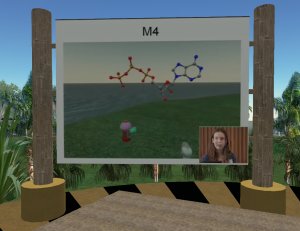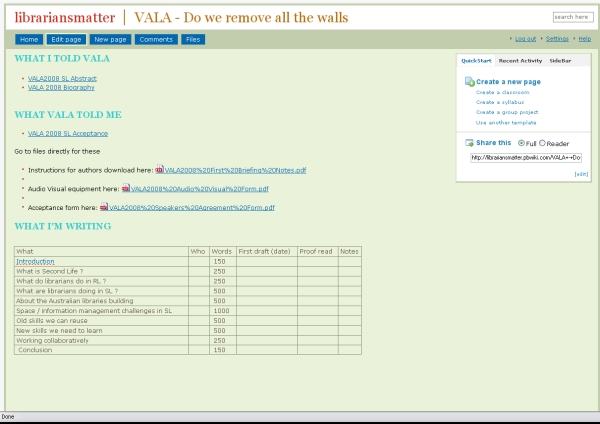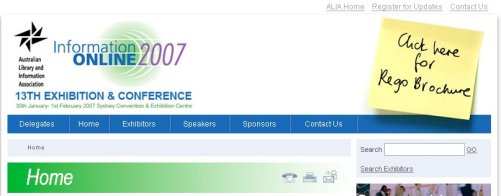Right now I’m on Cybrary City in Second Life attending the Eduserv Symposium Virtual Worlds Real Learning? which is being streamed live from the London . I’m having my first shot at liveblogging.
[Bit of a break in here. Below is a long steam copied as the speaker was talking, more or less untidied. The first two speakers aren’t nearly as interesting as Stephen Downes at the end, who had a brief to be provocative and took a technoskeptic line. He’s worth looking at.
The speakers were streamed into a large screen with audio, a small inset of their face talking in the corner of their presentation slides. As one of the SL audience said, we were still slaves to HorrorPoint.
In between speakers, I got some tips about resources for the introduction to Second Life classes I’m giving in the next few months, I teleported a friend who had noticed on twitter that I was at the symposium, and met with a blogger in remote Scotland whose blog I have read for the past 6 months or so, but hadn’t realised was involved with SL. ]

JOANNA SCOTT: Nature Publishing : SECOND NATURE
The first speaker is Joanna Scott from Nature Publishing, who publish the Science Journal, Nature.
Their island is called “Second Nature”. They started off with a couple of nifty installations, like a 3D display of molecules – you specify the molecule and a model appears in front of you. They also experimented with a representation of a cell.
They decided, however, that they don’t create content in their magazine, they take content from other scientists and they wanted to replicate this model in Second Life.
There have been several people who took up the offer to use the space, including a professor who teaches classes in Second Life and has a Blue Obelisk Cemetary where people can click on blue stones and take a quiz. The value turns out to be that lots of people stop by and chat about the subject area. Also the JCB Center for Open Notebook Science and the Gene Pool are other projects.
Would never consider putting the articles from the journal on the web.
“We don’t exactly know what we are doing in Second Life, and we don’t think anyone really does, but we can see the potential and we’re going to stay here”.
Could Second Life replace the Conference? She raised the point that Environmental Scientists are not attending conferences due to the impact of airflight.
Question: How to justify the time and energy put into SL
Answer: Her department is there to investigate things like this without producing immediate return. SL has potential to be really big, really important..don’t know how..but being there gives us the skills and ability to shape what the future of SL will be.
Question: Are other scientific journals doing anything in SL?
Not that she knows of, although Penguin publishers are there.
GILLY SALMON University of Leicester A SECOND GUESS AT THE FUTURE
Need to start exploiting potential of Second Life. Set up a Learning Futures Academy.
Universities don’t change very quickly 😉 so this project lets students envision how their university will look.
Not creating an artifact, but collaboratively creating a future.
Looking at what can do in SL that you CAN’T do in RL, not what you can do in SL that mirrors RL.
Imagining futures better.
Media Zoo – for evidence from media projects
Want to elicit viable and possible futures by interactive environement in SL. Have been messing about with it, but haven’t come up with the answers yet.
Shouldn’t be looking back in 5 years time and saying “oh, if only we’d known”. Hope to engage everyone now.
“Today’s students are not longer the people our education systems were designed to teach”
Designing for an unknown future.
Activities to innovate…1) Extend and defend core business 2) Build emerging business 3) Create viable options
Hope higher ed will begin focussing on 3).
SEAL research- Second Life Advanced Learning
Aim:
1) Surface learners’ choices
2) Build communities of learners
3) Create models of learning for the future
Methodologies for face to face environments aren’t applicable to SL. They are using Cognitive Mapping. Looked at successful models from other online applications. Work with futurists.
(Cognitive mapping = by Kelly 1955 )
Output: Want to create a framework of learning and a sharable model.
[comment from someone in the SL audience: we dont get far away from the lecture model at conferences even in SL. We’re slaves to power point]
Question: ethics and informed consent
Answer: can use existing approaches
STEPHEN DOWNES: Virtual Worlds in Context
Being cast as a Technoskeptic
Hearing a lot about SL. People are making points about the economics of SL. Gartner Hype Cycle mentioned again: “80% of all active Internet users will have a SL in a virtual world by 2011”. Is that really reasonable?
Teen Second Life library mentioned. When he saw the paper on Teen SL Library, particulalry noticed the “special permission” to librarians to be in Teen SL…language seemed odd for public education
It’s all so derivative. He’s pointing out the ridiculousness of it all. (But without spite I think). Branding in SL.
It’s like a scene from Star Trek until you hit the casinos. Buildings and nothing else. Look at map and see the little green dots where the people are, teleport down and there is a casino.
Clay Shirky. “I’ts a try me virus”.
When SL reached 38 K people online, it began kicking people out. “38K compared to the number of users in the internet is a rounding error”.
The media is largely push driven.
Where is open source in SL? Why was copybot killed?
People forget history. (eg. virtual reality). Before the internet, there was two sides..the gamers side and the text side. When people say SL is not a game, I hear myself saying “how is this not a game?”, when what people are doing is creating things and showing off cf. Sims city.
<SHIFT> Fund in Sim City , can get more dollars. Same in SL, you can cheat and buy Lindens. Crossover between MUDS, MUVES, MUSES, DIKUs.
Mult Academic User Domain. The Palace. Furcadia. Active Worlds.WoW.
Gartner Hype cycle. 5 laws of VRs
- Virtual worlds are not games (speaker: yes they are, but it’s OK)
- Every avatar is a real person
- Be relevant and add value
- Contain the downside
- This is a long haul (This is what your broker tells you just before the big crash.)
Real issues . David Noble. Digital Diploma Mills. Internet didn’t suddenly commercialise education, BUT the environment for education in SL is what Noble warned against.
Who owns SL? Not the users, not the learners. If you don’t subscribe, you get kicked off if it gets too busy.
Centralised. It’s all in one domain and it doesn’t work. Too much data and can’t be handled.
Can SL scale?
Interoperability. MUDS and Inter MUDS. People would chat between MUDS. Communications between MUDS. Issues of transport of goods.
[Audience comment: Isn’t that what Multiverse was about]?
Why do we tolerate something like SL where we can’t even own our own names.
SL taps into our latent conservativism. This is so NOT Web2.0. It doesn’t empower people. Pedagogy doesn’t change, power structures don’t change. No open standards. SL is where the traditional publishers are creating the content.
Why do people like SL? Is it because you can stream? Because you can lecture…Is that what is unique to SL. We have been able to do these already.
SL isn’t too good at communication. Try to have conversation in a group of 100 people.
Compare to IM, MySpace, YouTube, Skype, Wii.
How much in SL is being done just becuase it’s SL?
What is real value of SL?
1) SL has real economy
2) Can create ownership
3) World must be persistent
Is this the online learning we have been waiting for. Is private ownership what we were looking for ? Is it branding? Proprietary technology.
[Audience: I view SL as a prototype of a much more capable future 3D environment.]
Hardware and software should be distributed. Should be open source. Should be non-commercial. Should be diverse and democratic . Want to have ownership in our identities. This will create the Learning Common. But we won’t have it by 2011.
(He had been asked to be provocative)
Q: How can this be a game when I’m doing my professional work and making academic contacts in it
A: I got my start in academic circles via MUDS. Just because it’s a game doesn’t mean it can’t be those other things.






